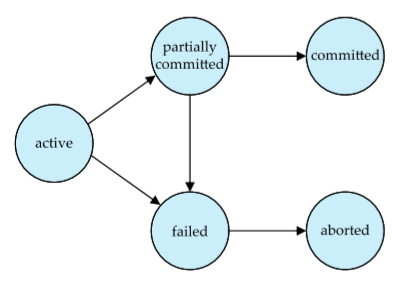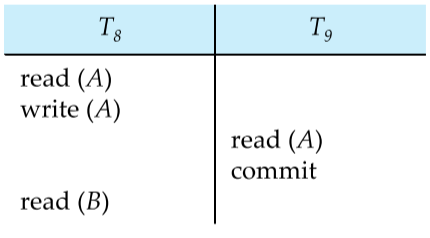Transactions
Transactions
A transaction is a unit of program execution that accesses and possibly updates various data items. Transactions have four main characteristics, abbreviated as the ACID properties.
- Atomicity - System should ensure that a partially executed transaction must not be reflected in the final database, irrespective of software or hardware failures.
- Consistency - Both explicit and implicit constraints of a database must be satisfied at the end of any transaction; it is possible that they might be violated during the transaction.
- Isolation - Other transactions should be unable to see the partially updated (and possibly inconsistent) database
- Durability - The changes made by a transaction must be reflected after successful completion, even if system failures occur.
There are five main states for a transaction:
- Active - transaction is being executed, is the initial state
- Partially Committed - Final statement of the transaction has been executed
- Failed - Normal execution can no longer occur
- Aborted - The transaction has been rolled back and the database has been restored. We can either restart the transaction (if error wasn’t logical) or kill it entirely
- Committed - Successful execution of transaction
There is no back arrow from aborted to active because restarting the transaction is the system’s job

Concurrency
Concurrency Control Schemes are the mechanisms used to achieve isolation. A schedule specifies the chronological order in which instructions of the concurrent transactions are executed. We assume each transaction to preserve database consistency. Moreover, we consider only read and write instructions for now.
Serializability
A schedule is said to be serializable if it is equivalent to a serial schedule of transactions. There are two main kinds of serialization:
- Conflict serializability
- View serializability
Conflict Serializability
Two instructions $I_i$ and $I_j$ belonging to transactions $T_i$ and $T_j$ are said to be conflicting if they both access the same item $Q$ and at least one of them writes to $Q$.
Schedules $S$ and $S’$ are said to be Conflict Equivalent if they can be interconverted by swapping non-conflicting instructions. $S$ is said to be Conflict Serializable if it is equivalent to a serial schedule.
View Serializability
Two transactions $S$ and $S’$ are said to be view equivalent if the following conditions hold for all data items $Q$. A schedule is View Serializable if it is equivalent to a serial schedule.
- If transaction $T_i$ reads the initial value of $Q$ in schedule $S$, then $T_i$ must read the initial value of $Q$ in $S’$ as well
- If transaction $T_i$ reads the value of $Q$ that was written by a
writeexecuted by $T_j$ in schedule $S$, then $T_i$ must read $Q$ that was written by the samewriteoperation by $T_j$ in $S’$ as well - The transaction performing the final write operation of $Q$ in $S$ must do so in $S’$ as well
==$\text{Conflict Serializable}\implies\text{View Serializable}$==
Blind writes (writing to $Q$ without reading it first) cause a view serializable schedule to not be conflict serializable.
==Two non-equivalent schedules may have the same outcome!==

Testing for Conflict Serializability - Precedence Graphs
Given the transactions $T_1, T_2,\ldots T_n$ we can construct a directed graph with the transactions as vertices. An edge $T_i\to T_j$ is added if there is conflict between them, and $T_i$ accesses the conflicting data item first. The edge may be labeled by the conflicting item.
==A schedule is Conflict Serializable iff its precedence graph is acyclic.== The serializability order can be obtained by topological sorting of the graph.
Testing for view serializability using precedence graphs is an NP-Hard problem, and thus the existence of an efficient algorithm is extremely unlikely.
Recoverable Schedules
A transaction $T_j$ reads a data item previously written by $T_i$, then $T_i$ should commit before $T_j$ for the schedule to be recoverable. The schedule given below is not recoverable, as $T_8$ could rollback after $T_9$ commits with an incorrect value that $T_8$ wrote to $A$.

Moreover, we would like cascading rollbacks to be absent so that much of the work done is not undone by a single transaction aborting. Schedules where cascading rollbacks do not occur are called as Cascade-less Schedules.
Cascade-less Schedules - Every $T_j$ that reads a data item written by $T_i$ must have its read(Q) operation after $T_i$ has committed
\[\text{Cascadeless Schedule}\implies\text{Recoverable Schedule}\]
Concurrency Control
Ideally, we would like the schedule decided to be conflict/view serializable, recoverable, and preferably cascade-less. There are different “levels” of consistency that databases might demand:
- Serializable
- Repeatable Read - Only committed records to be read, with repeated reads of the same record always returning the same value. The transaction may not be serializable
- Read Committed - only committed records can be read, but repeated reads may give different values
- Read Uncommitted - Even uncommitted records can be read
==Repeatable read and read committed??==
Lower levels of consistency are usually just used to gather approximate information about the database.
Phantom Phenomenon
Consider the following SQL transactions that we wish to execute concurrently.
# Transaction 1
select ID,name from instructor where salary > 90000
# Transaction 2
insert into instructor values ('11111', 'James', 'Marketing', 100000)
It is possible that T1 starts first, and locks the records which satisfy the where clause. However, if we were to then execute T2, tuple level locking is unable to detect this conflict!
We thus need to detect “predicate” conflicts, and use some form of predicate locking!
